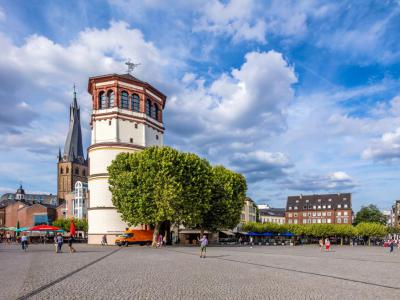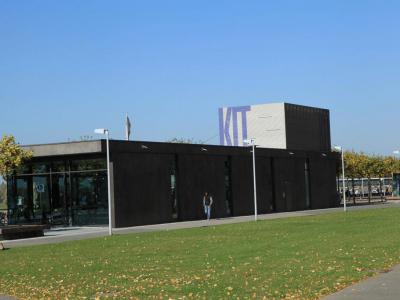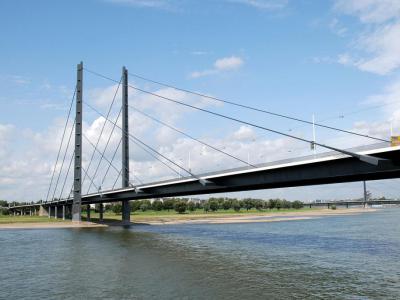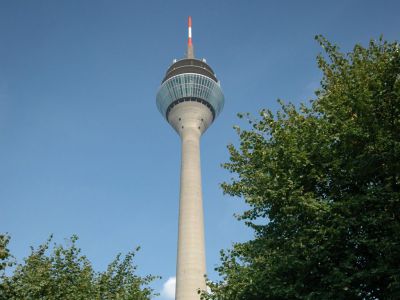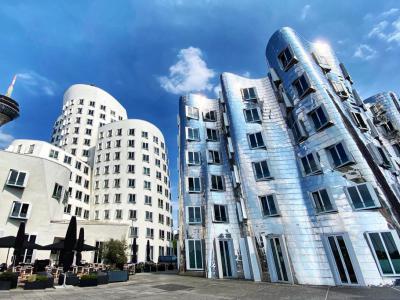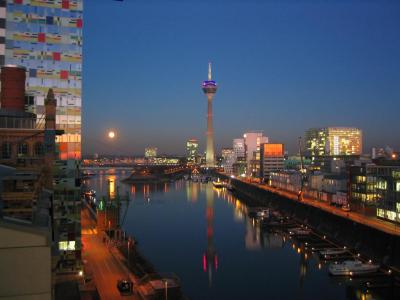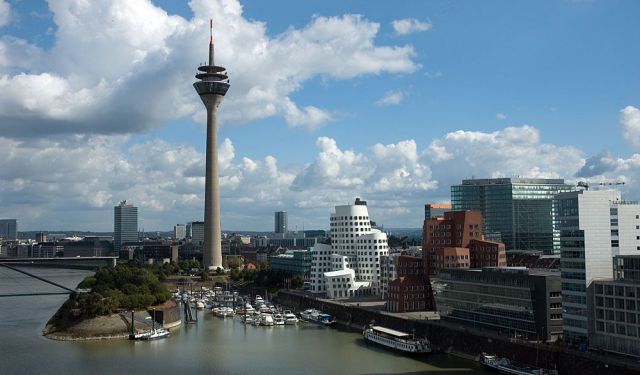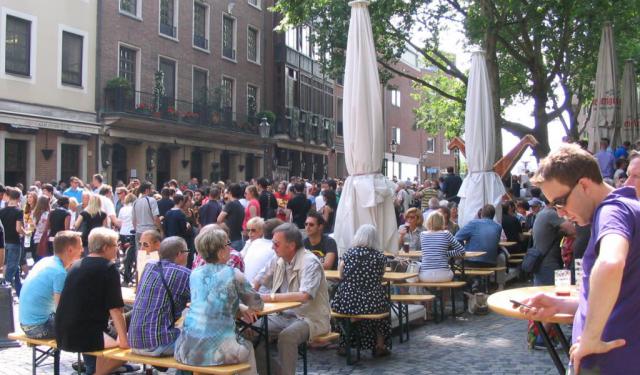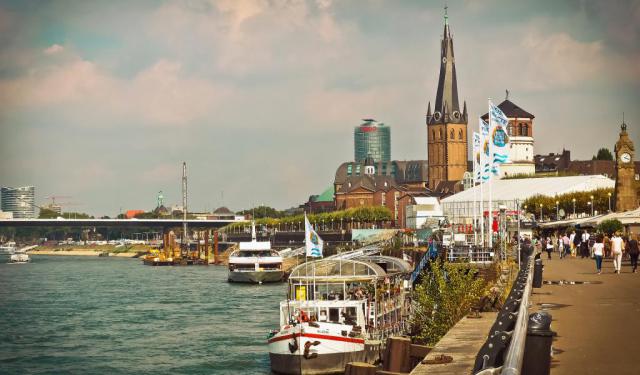
Rhine River Promenade Walk (Self Guided), Dusseldorf
The scenic Rheinuferpromenade (Rhine Promenade) is the lifeline of Dusseldorf. Currently one of the most beautiful places in the city and a very popular destination for both locals and tourists, this approximately 1.5-kilometer-long embankment was developed between 1990 and 1997 to a design by architect Niklaus Fritschi.
The project was easily one of the most successful waterfront transformations in Germany or anywhere else in Europe. Linking the city to the mighty Rhine, the promenade celebrates the cheerful spirit of Dusseldorf, offering gorgeous views, loads of attractions, not to mention endless gourmet opportunities, enabling the extension of evening and night-time activities straight to the river.
The Promenade starts at the historic Burgplatz, a large Castle Square that is itself well worth exploring. In warm summer weather, the outside stairs at Burgplatz are often filled with numerous sunbathers. Sometimes, some of them have a guitar on hand or street artists perform.
From here you can photograph many local landmarks, including the Rheinturm (Rhine Tower) – the city's tallest building, and the tenth tallest television tower in Germany. Down south, at the foot of another local high-riser, Mannesmann building, is the entrance to the subterranean Kunst im Tunnel (Art in the Tunnel) Gallery, established in 2007.
The promenade continues southward, past the Rheinkniebrücke (Rhine Knee Bridge), in the direction of the MedienHafen (Media Harbour). Opposite to the latter you can see the Colorium Building – a remarkable piece of modern architecture, covered in more than 2,000 color-printed glass panels.
To explore first-hand these and other attractions of the Rheinuferpromenade in Dusseldorf and to enjoy your visit to the fullest, take this self-guided walking tour.
The project was easily one of the most successful waterfront transformations in Germany or anywhere else in Europe. Linking the city to the mighty Rhine, the promenade celebrates the cheerful spirit of Dusseldorf, offering gorgeous views, loads of attractions, not to mention endless gourmet opportunities, enabling the extension of evening and night-time activities straight to the river.
The Promenade starts at the historic Burgplatz, a large Castle Square that is itself well worth exploring. In warm summer weather, the outside stairs at Burgplatz are often filled with numerous sunbathers. Sometimes, some of them have a guitar on hand or street artists perform.
From here you can photograph many local landmarks, including the Rheinturm (Rhine Tower) – the city's tallest building, and the tenth tallest television tower in Germany. Down south, at the foot of another local high-riser, Mannesmann building, is the entrance to the subterranean Kunst im Tunnel (Art in the Tunnel) Gallery, established in 2007.
The promenade continues southward, past the Rheinkniebrücke (Rhine Knee Bridge), in the direction of the MedienHafen (Media Harbour). Opposite to the latter you can see the Colorium Building – a remarkable piece of modern architecture, covered in more than 2,000 color-printed glass panels.
To explore first-hand these and other attractions of the Rheinuferpromenade in Dusseldorf and to enjoy your visit to the fullest, take this self-guided walking tour.
How it works: Download the app "GPSmyCity: Walks in 1K+ Cities" from Apple App Store or Google Play Store to your mobile phone or tablet. The app turns your mobile device into a personal tour guide and its built-in GPS navigation functions guide you from one tour stop to next. The app works offline, so no data plan is needed when traveling abroad.
Rhine River Promenade Walk Map
Guide Name: Rhine River Promenade Walk
Guide Location: Germany » Dusseldorf (See other walking tours in Dusseldorf)
Guide Type: Self-guided Walking Tour (Sightseeing)
# of Attractions: 7
Tour Duration: 1 Hour(s)
Travel Distance: 2.4 Km or 1.5 Miles
Author: ChristineS
Sight(s) Featured in This Guide:
Guide Location: Germany » Dusseldorf (See other walking tours in Dusseldorf)
Guide Type: Self-guided Walking Tour (Sightseeing)
# of Attractions: 7
Tour Duration: 1 Hour(s)
Travel Distance: 2.4 Km or 1.5 Miles
Author: ChristineS
Sight(s) Featured in This Guide:
- Burgplatz (Castle Square)
- Kunst im Tunnel (Art in the Tunnel)
- Rheinkniebrücke (Rhine Knee Bridge)
- Rheinturm (Rhine Tower)
- Neuer Zollhof (The New Zollhof)
- MedienHafen (Media Harbour)
- Colorium Building
1) Burgplatz (Castle Square) (must see)
Castle Square is located on the Rhine River, near the location of the original town. This open space was named after Dusseldorf Castle, which was originally built during the 14th century. The castle was built to collect tolls, hence its location right on the river. Dusseldorf Castle was mostly torn down in 1892, and the remaining castle tower houses a museum.
Dusseldorf Castle and Castle Square were the city's center for centuries. When the castle deteriorated and was removed, Castle Square became a bigger, more open area. The area changed again when a busy highway was built here after World War II.
Finally, the area was redesigned in 1995 when the Rhine Embankment Promenade was built. Visitors can take a flight of steps to reach the Rhine's banks from Castle Square. The square often hosts different festivals and events and the open space offers visitors and residents a convenient meeting place.
The northern part of Castle Square faces the Rhine and the castle tower. The square is paved with cobblestones, which adds to its charm. The Radschlager fountain was added in 1954 and features a depiction of two cartwheeling boys.
Castle Square features the popular Wheel of Vision Ferris Wheel. This is a popular attraction day and night and offers a relaxing way to get the best views of historic Dusseldorf.
Dusseldorf Castle and Castle Square were the city's center for centuries. When the castle deteriorated and was removed, Castle Square became a bigger, more open area. The area changed again when a busy highway was built here after World War II.
Finally, the area was redesigned in 1995 when the Rhine Embankment Promenade was built. Visitors can take a flight of steps to reach the Rhine's banks from Castle Square. The square often hosts different festivals and events and the open space offers visitors and residents a convenient meeting place.
The northern part of Castle Square faces the Rhine and the castle tower. The square is paved with cobblestones, which adds to its charm. The Radschlager fountain was added in 1954 and features a depiction of two cartwheeling boys.
Castle Square features the popular Wheel of Vision Ferris Wheel. This is a popular attraction day and night and offers a relaxing way to get the best views of historic Dusseldorf.
2) Kunst im Tunnel (Art in the Tunnel)
Kunst im Tunnel (KIT) is an underground exhibition space for contemporary art in Düsseldorf, which is also, and deservedly so, considered to be one of its best local landmarks for its unique construction. The gallery is housed in the so-called residual tunnel space, two meters beneath the Rhine Promenade, which was created during the construction of the Rhine bank tunnel. The exhibition room is located in the immediate vicinity of the state parliament of North Rhine-Westphalia and the Rheinkniebrücke, and was opened on February 10, 2007.
The 130 m² glazed entrance pavilion was built to a design by the Düsseldorf architectural firm, Fritschi Architekten, who also developed the Rhine Promenade itself, back in 1995. The underground exhibition area of total 888 m² is squeezed between two tunnel tubes for car traffic. The slightly curved tunnel space is 140 meters long and – tapering to a point – between eight and one meter wide. Towards the surface, two light wells, fitted with armored glass, have been created.
KIT is used for exhibiting contemporary art and is intended to complement the Düsseldorf exhibition landscape in a targeted manner. Shown here primarily are the works by young artists, graduates of the Düsseldorf Art Academy, as well as winners of the Düsseldorf Art Prize, with four planned exhibitions held each year.
The 130 m² glazed entrance pavilion was built to a design by the Düsseldorf architectural firm, Fritschi Architekten, who also developed the Rhine Promenade itself, back in 1995. The underground exhibition area of total 888 m² is squeezed between two tunnel tubes for car traffic. The slightly curved tunnel space is 140 meters long and – tapering to a point – between eight and one meter wide. Towards the surface, two light wells, fitted with armored glass, have been created.
KIT is used for exhibiting contemporary art and is intended to complement the Düsseldorf exhibition landscape in a targeted manner. Shown here primarily are the works by young artists, graduates of the Düsseldorf Art Academy, as well as winners of the Düsseldorf Art Prize, with four planned exhibitions held each year.
3) Rheinkniebrücke (Rhine Knee Bridge)
The Rheinkniebrücke, known in English as the Rhine Knee Bridge, is a six-langed, cable-stayed bridge over the Rhine. One of seven Rhine bridges in the city, the Rhine Knee Bridge is the only one that crosses at the knee of the Rhine, giving it its distinctive moniker. The bridge was constructed in 1969.
Plans for a bridge at this location began as early as 1912. Architect Bruno Schmitz and engineer Otto Blum were awarded the design. When the time actually came to construct the bridge, it was designed by architect Friedrich Tamms who was head of the Duesseldorf City Planning Office.
The entirety of the bridge is 1,519 meters long, which is just under one mile in length. However, the span over the Rhine is only about one-third of that length. The bridge has a singular pylon with two free-standing vertical stems. The steel bridge deck has cantilevered sidewalks and bike paths.
The bridge is known as part of the original Duesseldorf bridge family along with the Theodor Heuss Bridge and the Oberkassel Bridge.
Plans for a bridge at this location began as early as 1912. Architect Bruno Schmitz and engineer Otto Blum were awarded the design. When the time actually came to construct the bridge, it was designed by architect Friedrich Tamms who was head of the Duesseldorf City Planning Office.
The entirety of the bridge is 1,519 meters long, which is just under one mile in length. However, the span over the Rhine is only about one-third of that length. The bridge has a singular pylon with two free-standing vertical stems. The steel bridge deck has cantilevered sidewalks and bike paths.
The bridge is known as part of the original Duesseldorf bridge family along with the Theodor Heuss Bridge and the Oberkassel Bridge.
4) Rheinturm (Rhine Tower) (must see)
The Rheinturm, or Rhine Tower, is a 789-foot tall telecommunications tower. It carries broadcasts for radio and television but is best known for being the tallest building in the city. Along with its functional properties, the Rhine Tower is home to an observation deck and a revolving restaurant.
Construction on the tower began in 1979 and was completed in 1981. Largely made of reinforced concrete, the Rhine Tower weighs an impressive 22,500 tons. It was designed by architect Harald Deilmann, who is best known for his work on university buildings, theatres, hospitals and office buildings.
A sculptural clock on the Rhine Tower's shaft called Lichtzeitpegel, or Light Time Level, was designed by Horst H. Baumann. The number of dots represents the hour, minutes and seconds. It is the largest digital clock in the world.
The observation deck is open to the public daily from 10 am to midnight. The restaurant within the Rhine Tower, QOMO, is open from 6 pm to midnight.
Construction on the tower began in 1979 and was completed in 1981. Largely made of reinforced concrete, the Rhine Tower weighs an impressive 22,500 tons. It was designed by architect Harald Deilmann, who is best known for his work on university buildings, theatres, hospitals and office buildings.
A sculptural clock on the Rhine Tower's shaft called Lichtzeitpegel, or Light Time Level, was designed by Horst H. Baumann. The number of dots represents the hour, minutes and seconds. It is the largest digital clock in the world.
The observation deck is open to the public daily from 10 am to midnight. The restaurant within the Rhine Tower, QOMO, is open from 6 pm to midnight.
5) Neuer Zollhof (The New Zollhof)
Neuer Zollhof, or The New Zollhof, is a Duesseldorf landmark that is part of the city's redeveloped port area. The building complex consists of three separate buildings with curved architecture to mimic leaning towers. Construction on the landmark was completed in 1998.
The New Zollhof was designed by architect Frank O. Gehry. He used a variety of materials to create a modern and unique visage. The central building, made from stainless steel, reflects the white plaster and red brick buildings on each side. Each tower has a different height with the west tower being that tallest at 14 stories.
This area on the waterfront was previously occupied by warehouses before it was redeveloped. The new focus of the New Zollhof is to provide public spaces for the residents of the city while also offering space for culture and art.
The buildings of New Zollhof have become popular with tourists who visit Duesseldorf.
The New Zollhof was designed by architect Frank O. Gehry. He used a variety of materials to create a modern and unique visage. The central building, made from stainless steel, reflects the white plaster and red brick buildings on each side. Each tower has a different height with the west tower being that tallest at 14 stories.
This area on the waterfront was previously occupied by warehouses before it was redeveloped. The new focus of the New Zollhof is to provide public spaces for the residents of the city while also offering space for culture and art.
The buildings of New Zollhof have become popular with tourists who visit Duesseldorf.
6) MedienHafen (Media Harbour) (must see)
MedienHafen, or the Media Harbour in English, sits on the banks of the Rhine River. The renovation of the old harbor, which was previously occupied by warehouses and abandoned buildings, led to a lively, exciting and modern area. Media Harbour is frequented by locals as well as tourists who want to see the best of Duesseldorf's art and culture.
The harbor's renovation began in the 1990s. Arguably the most spectacular view in the harbor is that of New Zollhof. Also known as the Gehry Buildings, New Zollhof stands out on the shoreline. Likewise, the Rheinturm (Rhine Tower) is located in Media Harbour. This tallest building in the city has an excellent restaurant and an observation deck.
Another prominent landmark in the Media Harbour is the Energie-Pyramide. The public artwork was crafted by sculptors Thomas Schonauer and Berend F. van Laar in 1988. It is made of stainless, igneous rock and basalt lava.
Most of the buildings in the Media Harbour are contemporary offices and media firms. There are also a number of shopping areas with fashion brands as well as restaurants, bars and a theatre. Many of these buildings are designed by internationally lauded architects, which creates an interesting mix of the old world with modern sights.
A walk along Media Harbour might include a stop at the scenic vista of Brucke am Medianhafen, or Media Harbour Bridge. Tourists may use this bridge to reach the Paradiesstrand Düsseldorf Hafen, a wildlife refuge that has a beach and a swimming area. Those who would rather focus on art and culture could try the Kunstgiesserei Kayser art center or the Arthena Foundation art gallery.
The harbor's renovation began in the 1990s. Arguably the most spectacular view in the harbor is that of New Zollhof. Also known as the Gehry Buildings, New Zollhof stands out on the shoreline. Likewise, the Rheinturm (Rhine Tower) is located in Media Harbour. This tallest building in the city has an excellent restaurant and an observation deck.
Another prominent landmark in the Media Harbour is the Energie-Pyramide. The public artwork was crafted by sculptors Thomas Schonauer and Berend F. van Laar in 1988. It is made of stainless, igneous rock and basalt lava.
Most of the buildings in the Media Harbour are contemporary offices and media firms. There are also a number of shopping areas with fashion brands as well as restaurants, bars and a theatre. Many of these buildings are designed by internationally lauded architects, which creates an interesting mix of the old world with modern sights.
A walk along Media Harbour might include a stop at the scenic vista of Brucke am Medianhafen, or Media Harbour Bridge. Tourists may use this bridge to reach the Paradiesstrand Düsseldorf Hafen, a wildlife refuge that has a beach and a swimming area. Those who would rather focus on art and culture could try the Kunstgiesserei Kayser art center or the Arthena Foundation art gallery.
7) Colorium Building
The Colorium is a speculative office development resting along the Rhine in the Media Harbour. This building was designed by architect Will Alsop in 2001. The tower is made of concrete with aluminum, glass and steel to accentuate the modern architecture.
The 17-story Colorium has over 2,200 color-printed glass panels. The panels range in shades of blue, orange, yellow, red, black, white and green. They are made of insulating glass with internal sun protection. The exterior shades of each area is reflected inside with a matching color scheme.
The original plan for the Colorium was as a mixed-space office and residential area. The plan was to have office space and office lofts for a living/working environment. It also included a restaurant. The tower was fully converted into a hotel in 2013. The hotel has 134 rooms.
The 17-story Colorium has over 2,200 color-printed glass panels. The panels range in shades of blue, orange, yellow, red, black, white and green. They are made of insulating glass with internal sun protection. The exterior shades of each area is reflected inside with a matching color scheme.
The original plan for the Colorium was as a mixed-space office and residential area. The plan was to have office space and office lofts for a living/working environment. It also included a restaurant. The tower was fully converted into a hotel in 2013. The hotel has 134 rooms.
Walking Tours in Dusseldorf, Germany
Create Your Own Walk in Dusseldorf
Creating your own self-guided walk in Dusseldorf is easy and fun. Choose the city attractions that you want to see and a walk route map will be created just for you. You can even set your hotel as the start point of the walk.
Dusseldorf Introduction Walking Tour
The area at the confluence of the Rhine and Dussel rivers was on the outskirts of the Roman Empire and settled by Germanic fishing tribes. It is from these small beginnings that the town takes its name. "Dorf" translates to "village" in English. The city of Dusseldorf has since grown far larger than that original eighth-century fishing village.
Dusseldorf was first elevated... view more
Tour Duration: 2 Hour(s)
Travel Distance: 2.3 Km or 1.4 Miles
Dusseldorf was first elevated... view more
Tour Duration: 2 Hour(s)
Travel Distance: 2.3 Km or 1.4 Miles
Dusseldorf's Old Beer (Altbier) Walk
Just as London has given us Porter, Dublin – Stout, Burton – the original (English) IPA, and Cologne – Kolsch, Dusseldorf has contributed to the world of beers its signature Altbier. They say, Dusseldorf and Altbier go together like onion rings and blood sausage. Curiously enough, though, this delicious, cool-fermented and malty brew, ranging in color from dark brown to copper, is not... view more
Tour Duration: 1 Hour(s)
Travel Distance: 1.1 Km or 0.7 Miles
Tour Duration: 1 Hour(s)
Travel Distance: 1.1 Km or 0.7 Miles
The Most Popular Cities
/ view all
